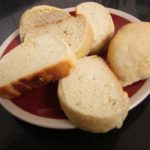Everyone loves Croissants. You are inhuman if you don’t. And after I finally made them from scratch yesterday I found out exactly why they taste so freaking brilliant. Because of all the butter. And because of all the Work! I thought making tarts was work but after yesterday I could makes those with one hand. Okay that is reaching out too far, I need two hands but I not so much time and effort.
If I could make a comparison, I would do it with the Laccha Paratha that we all love so much. Or the Kerala Parotta, with layers of flaky wheat and ghee. Only, in the case of both the before mentioned breads, the dough is not fermented with yeast and thus the preparation time decreases monumentally.
While the origins of this buttery flaky bread vary, it can be safely said to have been born in Europe and is one of my favourite breakfast foods. Unfortunately, I do not live nearby a quaint little bakery which would sell me these while I reach there in my bicycle (I don’t live in the US or Europe). So in a fit of desperation I decided to make them at home. How difficult could they be? I thought to myself. Was I wrong!
To those who haven’t yet understood how exactly the final multi layered product is created, the technique is quite simple. After the preparation of the main dough, it is rolled out and a thin but big slab of butter is placed on it. After this, the dough is folded (much like a napkin) and rolled many time, over and over again, to create the many layers of dough and butter in the final product. The problem here is that since butter melts at room temperature, after every fold and roll, the whole thing has to be refrigerated for an hour before you can make another fold. That’s at least 3 hours for making 3 rolls. Add to that at least 4 hours for the dough to rise twice before you can place the butter in it, and you know what a lengthy process making these delicious babies it.
Surprisingly, cutting and shaping the croissants turned out to be the easiest thing in the entire process. Just make triangles out of the dough, and roll from the widest end to the shortest. Voila!
The one thing that you should remember though is to let the dough rest on the kitchen counter for 5 minutes before you roll it otherwise the butter with break into chunks inside it. And also, use unsalted butter. I used salted Amul butter because of lack of resources, and though the final product turned out to be completely delicious, I could not imagine slathering them with more butter while eating them, which I otherwise always do.
If you an experimental sort who is up for a challenge then I would strongly suggest you trying this out. The result is deeply gratifying.
Ingredients
1 1/4 teaspoons dry active yeast
Warm water
1 teaspoon sugar
220g flour
1 1/2 teaspoons salt
1/2 cup (120 ml) milk
2 tablespoons vegetable oil
115g unsalted butter, chilled
1 egg
Making the Dough
- Take 3 tsp of the warm water into a bowl. Add the sugar, salt and yeast in a bowl, and let it sit for 5 to 10 minutes, until it foams and bubbles.
- Warm the milk (not boil) in a pan on the stove. Place the the flour, warm milk, yeast mixture and oil in a bowl.
- Mix together and make a dough out of it. Place the dough in a bowl dusted with four and keep it aside to rest for 2 hours. Cover the bowl with a dish towel.
- After two hours, the dough should have doubled in size. Take it out, and press it into a rectangle (20×30 cm) with a rolling pin. Then fold it three times, first left third, then right third. This is called ‘turning’.
Let the dough rise again for 1 hour. Then place it in the refrigerator for 30 minutes.
Making the butter layers
- Put a large wax paper (butter paper) on the counter. I used polythene, works just as fine.
- Put the butter on it and then fold the rest of the paper over it.
- Basically what we have to do now is shape the slab of butter into a rectangle (30x15cm) by beating and rolling it and not let it melt. After you are done then put it in the fridge.
- After 30 min, take out your dough from the fridge.
- Flatten it into a (35×20 cm) rectangle. Place the rectangle of butter in the center of the rectangle of dough, lining it up so that it is at least a half-inch away from the edge of the dough.
- Then turn the dough like earlier. Make sure the butter is evenly layered and folded up with the dough.
- Roll the dough into a rectangle again. You are rolling the butter and the dough while doing so.
- Turn the dough again (1). Refrigerate for an hour.
- Repeat the above action (2). Refrigerate for an hour.
- Repeat the above action (3). Refrigerate for an hour.
Prepare for cutting.
- Dust the counter top with flour.
- Remove the dough from the refrigerator, and let it rest on the counter top for 10 minutes.
- Finally, roll the dough into a (50×12 cm) rectangle.
- Cut the dough 5 times lengthwise so that you have 6 squares.
- Cut them diagonally so you have 12 triangles, which will each become your croissants.
- Roll a dough triangle into a croissant.
- Starting at the widest side, roll the dough upward to the top of the triangle.
- You should end up with 12 croissants on your buttered baking sheet.
- Cover the baking sheet loosely with a clean dishtowel, and allow the croissants to rise for an hour.
Baking the Croissants
- Preheat the oven to 220°C
- Break the egg into a small bowl, and use a fork to mix it up with 1 teaspoon of water.
- Brush the egg wash over the tops of the croissants with a brush.
- Bake the croissants for 20 minutes. They should be golden brown on top when they’re done.























